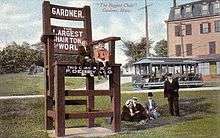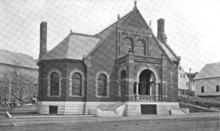Gardner, Massachusetts
Gardner is a city in Worcester County, Massachusetts, United States. The population was 20,228 at the 2010 census. Gardner is home to Dunn State Park, Gardner Heritage State Park, Lake Wampanoag Wildlife Sanctuary, and Mount Wachusett Community College.
Gardner, Massachusetts | |
|---|---|
City | |
 | |
 Flag | |
| Nickname(s): Chair City[1] | |
 Location in Worcester County and the state of Massachusetts. | |
 Gardner, Massachusetts Location in the United States | |
| Coordinates: 42°34′30″N 71°59′55″W | |
| Country | United States |
| State | Massachusetts |
| County | Worcester |
| Settled | 1764 |
| Incorporated | 1785 |
| Government | |
| • Type | Mayor-council city |
| • Mayor | Michael J. Nicholson [2] |
| • City Council | Scott Graves George Tyros James Boone Ronald Cormier Craig Cormier Judy Mack James Walsh (Ward 1) Elizabeth Kazinskas (Ward 2) Nathan Boudreau (Ward 3) Karen Hardern (Ward 4) Aleksander Dernalowicz (Ward 5) |
| Area | |
| • Total | 23.02 sq mi (59.61 km2) |
| • Land | 22.07 sq mi (57.15 km2) |
| • Water | 0.95 sq mi (2.45 km2) |
| Elevation | 1,100 ft (324 m) |
| Population (2010) | |
| • Total | 20,228 |
| • Estimate (2019)[4] | 20,683 |
| • Density | 937.24/sq mi (361.88/km2) |
| Time zone | UTC−5 (Eastern) |
| • Summer (DST) | UTC−4 (Eastern) |
| ZIP Code | 01440 |
| Area code(s) | 978/351 |
| FIPS code | 25-25485 |
| GNIS feature ID | 0610059 |
| Website | www.gardner-ma.gov |
History
Named in honor of Col. Thomas Gardner,[5] the community was first settled in 1764 and officially incorporated as a town in 1785 after receiving land grants from the surrounding towns of Ashburnham, Westminster, Templeton and Winchendon.[6]:2 Dating from about 1805, it became a center for lumber and furniture industries. Gardner is known as the "Chair City" and "The Furniture Capital of New England", due to its long history in furniture production.[1] By 1910 it had 20 chair factories which produced 4 million chairs per year. It was also noted for silversmithing. The Gardner State Colony for the Insane pioneered the use of cottage residences. Gardner was incorporated as a city in 1923.
Gardner is the birthplace of Heywood-Wakefield Company, dating from 1826 when the five Heywood brothers began to fashion furniture in a barn near their father's farm. Brothers Walter, Levi, Seth, Benjamin and William began that year making wooden chairs. In the early years, Walter fashioned chairs by hand, also using a foot lathe. He was soon joined by his brothers Levi and Benjamin, part-time, while running a nearby country store. A new store was built across the street from the original store. In 1831 Levi moved to Boston where he established an outlet store to sell the chairs, while Benjamin and William remained in Gardner to manufacture the chairs. A fire destroyed the Heywoods' chair shop in 1834. In 1835 the partnership of B. F. Heywood & Co. was formed, composed of Benjamin, Walter and William, with Moses Wood and James W. Gates. Gardner was also the home of the Conant-Ball furniture factory. Nichols & Stone Chair Company traces their origin to 1762 in Westminster, Massachusetts. The company moved to Gardner at the turn of the 20th century. As of July 2008, it was announced they would terminate production. The Nichols & Stone name, the intellectual property and the design rights were purchased by the L. & J.G. Stickley of Manlius, New York.[7]
Gardner is also home to the first practical time clock. Invented in 1894, by Edward G. Watkins, while he was an engineer working at Heywood-Wakefield Company when he was asked to make a better time clock to keep better track of their workers. After recognizing growing nationwide need for a better time clock, Watkins left Heywood-Wakefield, and opened Simplex Time Recorder. In 1958, Simplex bought the IBM Time Recorder Division, which also included their fire protection division. This purchase helped propel Simplex to become a leader in fire alarms and business systems. Simplex would be owned and operated under the Watkins family for over a century with family including Edward's son, Curt, from 1942 to 1967, and Curt's son, Edward "Chris" G. II, from 1967 until it was sold in 2000, to Tyco International.
 Biggest Chair, c. 1910
Biggest Chair, c. 1910 Elm Street, c. 1908
Elm Street, c. 1908 Chestnut Street, c. 1906
Chestnut Street, c. 1906
City seal
The seal of Gardner was designed in 1922 by native-born illustrator Walter Harrison Cady. According to the city code, the seal shows a portrayal of Col. Thomas Gardner standing in front of Crystal Lake with Mount Monadnock in the background. Within five smaller circles we see a chair, representing the importance of the furniture industry to the city's economy, as well as the letters W, W, A, and T, representing the surrounding towns of Westminster, Winchendon, Ashburnham, and Templeton which all contributed land to the city at its founding.[8][9]
Geography
Gardner is located at 42°34′26″N 71°59′27″W (42.573920, -71.990818).[10]
According to the United States Census Bureau, the city has a total area of 23.0 square miles (60 km2), of which 22.2 square miles (57 km2) is land and 0.8 square miles (2.1 km2), or 3.52%, is water. Gardner is situated on Crystal Lake. The highest point in the city is the summit of Reservoir Hill, close to the center of the city, with an elevation of over 1,280 feet (390 m) above sea level.[11]
Gardner is bordered by Winchendon and Ashburnham to the north, Westminster to the east, Hubbardston to the south, and Templeton to the west, all in Massachusetts.
Demographics
| Year | Pop. | ±% |
|---|---|---|
| 1790 | 531 | — |
| 1800 | 667 | +25.6% |
| 1810 | 815 | +22.2% |
| 1820 | 911 | +11.8% |
| 1830 | 1,023 | +12.3% |
| 1840 | 1,260 | +23.2% |
| 1850 | 1,533 | +21.7% |
| 1860 | 2,646 | +72.6% |
| 1870 | 3,333 | +26.0% |
| 1880 | 4,988 | +49.7% |
| 1890 | 3,424 | −31.4% |
| 1900 | 10,813 | +215.8% |
| 1910 | 14,699 | +35.9% |
| 1920 | 16,971 | +15.5% |
| 1930 | 19,399 | +14.3% |
| 1940 | 20,206 | +4.2% |
| 1950 | 19,581 | −3.1% |
| 1960 | 19,038 | −2.8% |
| 1970 | 19,748 | +3.7% |
| 1980 | 17,900 | −9.4% |
| 1990 | 20,125 | +12.4% |
| 2000 | 20,770 | +3.2% |
| 2010 | 20,228 | −2.6% |
| 2019 | 20,683 | +2.2% |
| * = population estimate. Source: United States Census records and Population Estimates Program data.[12][13][14][15][16][17][18][19][20][21][22] Source: | ||

As of the census[24] of 2000, there were 20,770 people, 8,282 households, and 5,085 families residing in the city. The population density was 936.0 people per square mile (361.4/km2). There were 8,838 housing units at an average density of 398.3 per square mile (153.8/km2). The racial makeup of the city was 93.13% White, 2.29% African American, 0.34% Native American, 1.37% Asian, 0.08% Pacific Islander, 1.22% from other races, and 1.58% from two or more races. Hispanic or Latino of any race were 4.08% of the population, while 19.6% were of French Canadian, 17.6% French, 12.7% Irish, 6.7% English, 6.3% Polish and 6.2% Italian ancestry according to Census 2000.
There were 8,282 households, out of which 30.3% had children under the age of 18 living with them, 44.4% were married couples living together, 12.7% had a female householder with no husband present, and 38.6% were non-families. Of all households 32.4% were made up of individuals, and 13.5% had someone living alone who was 65 years of age or older. The average household size was 2.35 and the average family size was 2.97.
In the city, the population was spread out, with 23.7% under the age of 18, 7.7% from 18 to 24, 31.8% from 25 to 44, 20.7% from 45 to 64, and 16.1% who were 65 years of age or older. The median age was 38 years. For every 100 females, there were 105.1 males. For every 100 females age 18 and over, there were 103.7 males.
The median income for a household in the city was $37,334, and the median income for a family was $47,164. Males had a median income of $35,804 versus $26,913 for females. The per capita income for the city was $18,624. About 7.0% of families and 9.6% of the population were below the poverty line, including 12.8% of those under age 18 and 11.7% of those age 65 or over.
The town is home to Gardner High School, which has a student population of about 800.
A city with a historically large population speaking a second language, today approximately 5.6% of all residents speak Spanish at home while 2.8% regularly speak New England French.[25]
Economy
Throughout its history Gardner was known for its furniture industry, earning its nickname as the "Chair City". While the city has undergone deindustrialization in recent decades a handful of manufacturers remain in Gardner and its neighboring towns, including Standard Chair of Gardner and the Saloom Furniture Company.[26][27] The city is also home to a multinational paper and packaging manufacturer, Seaman Paper.
Library

The public library in Gardner opened in 1885.[28][29] The original library building is now a museum of Gardner's history. In fiscal year 2008, the city of Gardner spent 1.84% ($734,164) of its budget on its public library—some $35 per person.[30]
Public transportation
Public transportation for Gardner is largely supplied by the Montachusett Regional Transit Authority (MART). MART operates local fixed-route bus services, shuttle services, as well as paratransit services within the Montachusett Region.[31]
Beginning in 1871, the Boston, Barre and Gardner Railroad provided rail service to the town. Gardner station was the terminus of the MBTA's Fitchburg Line from 1980 to 1986, but the line was cut back to Fitchburg at the beginning of 1987.[32] MART began weekday van service from Gardner to the new Wachusett terminus of the Fitchburg line in 2016.[33]
Events
| County-level state agency heads | |
|---|---|
| Clerk of Courts: | Dennis P. McManus (D) |
| District Attorney: | Joe Early Jr. (D) |
| Register of Deeds: | Katie Toomey (D) |
| Register of Probate: | Stephanie Fattman (R) |
| County Sheriff: | Lew Evangelidis (R) |
| State government | |
| State Representative(s): | Jonathan Zlotnik (D) |
| State Senator(s): | Dean Tran (R) |
| Governor's Councilor(s): | Jen Caissie (R) |
| Federal government | |
| U.S. Representative(s): | Lori Trahan (D-3rd District), |
| U.S. Senators: | Elizabeth Warren (D), Ed Markey (D) |
- The Annual Chair Luge, started in 2009, takes place the last Saturday in September during the Oktoberfest "Party in the Street" at the Gardner Ale House in Downtown Gardner and features teams of two racing down the streets in homemade chairs on wheels.
- For many years, the Gardner Municipal Golf Course has been home to the Central Massachusetts High School Cross Country District Championships. Every three years, it is also home to the Massachusetts High School State Cross Country Championships. The course record for the hilly 2.9-mile (4.7 km) course is 14:00 set by Andy Powell in 1998 while Lynn Jennings has the girls' record with a time of 15:50 from 1977.
- Home of the largest Relay For Life event in New England.
Notable people
- Larry Alexander, Massachusetts state legislator
- Red Blanchard, radio personality
- Walter Harrison Cady, illustrator
- Jacques Cesaire, former NFL defensive end for the San Diego Chargers and current assistant defensive line coach for the Buffalo Bills
- Oliver Drake, relief pitcher for the Tampa Bay Rays in the MLB
- Mark Gearan, former head of the Peace Corps under President Bill Clinton, former president of Hobart and William Smith Colleges and current director of the Harvard Institute of Politics
- Levi H. Greenwood, President of the Massachusetts Senate from 1912-1913
- Nicholas LaRoche, former professional American figure skater
- Hadassah Lieberman, wife of U.S. Senator from Connecticut and 2000 Democratic nominee for Vice President Joseph Lieberman
- Bob Menne, PGA Tour golfer
- Lucy Stone, women's rights activist, whose house still stands on Elm Street
- Frank Morze, Center San Francisco 49ers 1957-1961
- William Henry Wilder member of the United States House of Representatives from 1911-1913
- George Clinton Sweeney United States District Judge of the United States District Court for the District of Massachusetts from 1935–1966.
In popular culture
Gardner was a filming location for the 1992 movie School Ties.
Gardner is one of the current filming locations for the Hulu series Castle Rock (TV series) based on the book by Stephen King
See also
References
- "Collections: Chair & Furniture". The Gardner Museum, Inc. Retrieved 28 March 2018.
- "Mayor's Office". Gardner Massachusetts. Archived from the original on 26 September 2015. Retrieved 17 September 2015.
- "2019 U.S. Gazetteer Files". United States Census Bureau. Retrieved July 25, 2020.
- "Population and Housing Unit Estimates". United States Census Bureau. May 24, 2020. Retrieved May 27, 2020.
- Gannett, Henry (1905). The Origin of Certain Place Names in the United States. Govt. Print. Off. pp. 134.
- Glazier, Lewis (1860). . Worcester: Chas. Hamilton – via Wikisource.
- "Stickley Acquires Assets of Nichols & Stone" (PDF) (Press release). Manlius, NY. L. & J.G. Stickley, Inc. 2008-07-07. Retrieved 2017-06-16.
- Faust, James A.; Kadlik, Gayle (2012). Heywood Hospital. Arcadia Publishing. p. 19.
- "Chapter 252: Seal, City of Gardner Code". eCode360. 9 October 2016. Archived from the original on 2016-09-08. Retrieved 17 September 2015.
- "US Gazetteer files: 2010, 2000, and 1990". United States Census Bureau. 2011-02-12. Retrieved 2011-04-23.
- U.S. Geological Survey 7.5 x 15 minute topographic map series, Gardner quadrangle
- "Total Population (P1), 2010 Census Summary File 1". American FactFinder, All County Subdivisions within Massachusetts. United States Census Bureau. 2010.
- "Massachusetts by Place and County Subdivision - GCT-T1. Population Estimates". United States Census Bureau. Retrieved July 12, 2011.
- "1990 Census of Population, General Population Characteristics: Massachusetts" (PDF). US Census Bureau. December 1990. Table 76: General Characteristics of Persons, Households, and Families: 1990. 1990 CP-1-23. Retrieved July 12, 2011.
- "1980 Census of the Population, Number of Inhabitants: Massachusetts" (PDF). US Census Bureau. December 1981. Table 4. Populations of County Subdivisions: 1960 to 1980. PC80-1-A23. Retrieved July 12, 2011.
- "1950 Census of Population" (PDF). Bureau of the Census. 1952. Section 6, Pages 21-10 and 21-11, Massachusetts Table 6. Population of Counties by Minor Civil Divisions: 1930 to 1950. Retrieved July 12, 2011.
- "1920 Census of Population" (PDF). Bureau of the Census. Number of Inhabitants, by Counties and Minor Civil Divisions. Pages 21-5 through 21-7. Massachusetts Table 2. Population of Counties by Minor Civil Divisions: 1920, 1910, and 1920. Retrieved July 12, 2011.
- "1890 Census of the Population" (PDF). Department of the Interior, Census Office. Pages 179 through 182. Massachusetts Table 5. Population of States and Territories by Minor Civil Divisions: 1880 and 1890. Retrieved July 12, 2011.
- "1870 Census of the Population" (PDF). Department of the Interior, Census Office. 1872. Pages 217 through 220. Table IX. Population of Minor Civil Divisions, &c. Massachusetts. Retrieved July 12, 2011.
- "1860 Census" (PDF). Department of the Interior, Census Office. 1864. Pages 220 through 226. State of Massachusetts Table No. 3. Populations of Cities, Towns, &c. Retrieved July 12, 2011.
- "1850 Census" (PDF). Department of the Interior, Census Office. 1854. Pages 338 through 393. Populations of Cities, Towns, &c. Retrieved July 12, 2011.
- "1950 Census of Population" (PDF). 1: Number of Inhabitants. Bureau of the Census. 1952. Section 6, Pages 21-7 through 21-09, Massachusetts Table 4. Population of Urban Places of 10,000 or more from Earliest Census to 1920. Retrieved July 12, 2011. Cite journal requires
|journal=(help) - "Census of Population and Housing". Census.gov. Retrieved June 4, 2015.
- "U.S. Census website". United States Census Bureau. Retrieved 2008-01-31.
- "Language Spoken At Home By Ability To Speak English For The Population 5 Years And Over; American FactFinder". United States Census Bureau. Archived from the original on 2020-02-13. Retrieved 2018-10-10.
- "College Chairs". Standard Chair of Gardner. Retrieved December 27, 2018.
- "The 2018 Living Collection". Saloom Furniture Company. Retrieved December 27, 2018.
- C.B. Tillinghast. The free public libraries of Massachusetts. 1st Report of the Free Public Library Commission of Massachusetts. Boston: Wright & Potter, 1891. Google books
- Levi Heywood Memorial Library Archived 2011-05-01 at the Wayback Machine Retrieved 2010-11-10
- July 1, 2007 through June 30, 2008; cf. The FY2008 Municipal Pie: What's Your Share? Commonwealth of Massachusetts, Board of Library Commissioners. Boston: 2009. Available: Municipal Pie Reports Archived 2012-01-23 at the Wayback Machine. Retrieved 2010-08-04
- "Montachusett Regional Transit Authority". Archived from the original on 11 October 2012. Retrieved 4 October 2012.
- Belcher, Jonathan (31 August 2012). "Changes to Transit Service in the MBTA district" (PDF). NETransit. Retrieved 4 October 2012.
- "Wachusett Shuttles Montachusett Regional Transit Authority". Montachusett Regional Transit Authority. Retrieved 2 Apr 2017.
- Rouland, Steve Heywood-Wakefield Modern Furniture, 1994.
Further reading
- Glazier, Lewis (1860). . Worcester, Mass.: Chas. Hamilton. LCCN 01011393 – via Wikisource.
- Herrick, William D. (1878). History of the Town of Gardner, Worcester County, Mass., from the incorporation, June 27, 1785, to the present time. Gardner, Mass. LCCN 01011394.
- Moore, Esther G. (1967). History of Gardner, Massachusetts, 1785–1967. Gardner, Mass. LCCN 67066416.
External links
| Wikimedia Commons has media related to Gardner, Massachusetts. |
| Wikisource has several original texts related to: Gardner, Massachusetts |


